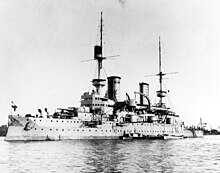SMS Kaiser Friedrich III.
|
||||||||||||||||||||||
|
||||||||||||||||||||||
|
||||||||||||||||||||||
|
||||||||||||||||||||||
SMS Kaiser Friedrich III. was a ship of the line of the Imperial Navy . Named after Emperor Friedrich III. (1831–1888), German Emperor and King of Prussia, she was the type ship of the first newbuildings since the Brandenburg class , initially as the Kaiser class, after the commissioning of the large-line ships of the new Kaiser class , then as Kaiser Friedrich Class or as the "old Kaiser class" were designated.
The ship was laid on Kiel as an armored ship I. Class replacement Prussia in 1895 at the Kaiserliche Werft Wilhelmshaven under construction number 22, with Kaiser Wilhelm II , the son of the namesake, hammering the first "nail" . In 1899 it was reclassified as a ship of the line.
history
After commissioning on October 7, 1898, the ship was in the testing phase until February 1899 and was in active service as the flagship of the I. Squadron from October 21, 1899 after completing small remaining work . In this association it performed its fleet service, took part in maneuvers and training trips and performed representative tasks as an escort ship for the Kaiserjacht Hohenzollern in December 1899. After a serious accident, the ship was taken out of service for nine months in 1901. In 1907 the ship was taken out of service again. It was fundamentally rebuilt and modernized from 1908 to 1910. After that it was part of the reserve formation of the Baltic Sea.
With the outbreak of war in 1914, it was reactivated and assigned to the 5th Squadron. Its use was initially limited to coastal protection in the North Sea and sporadic activities in the Baltic Sea. From March 1915, the ship was pulled out of the front along with the other ships of its class and the crew was reduced. The final decommissioning took place on November 20, 1915, with the ship being disarmed immediately (the 24 cm guns came to the western front as a railway battery) and used as a prisoner living quarters initially in Kiel and later in Flensburg. The demolition work began after the deletion from the fleet list in 1920 in Kiel-Nordmole.
The bow ornament of Emperor Friedrich III. is in the Military History Museum of the Bundeswehr in Dresden.
modification
During the major renovation, the appearance was changed significantly. The midship superstructure, two decks high, was removed and the chimney casings restricted to the lower half. The martial-looking battle masts were replaced by slender fore masts with rods. The four 15 cm matte guns of the middle artillery in the battery deck were expanded, the light artillery was reinforced by two 8.8 cm guns and their placement was changed, whereas the twelve automatic cannons were no longer available. The swiveling 45 cm surface torpedo tube in the stern was also removed. The formerly clumsy and top-heavy ships made a pretty bare impression after the renovation.
Average of April 2, 1901
On this day the 1st Squadron was on the march from Danzig to Kiel. During a forced voyage at 1:23 a.m. at night, the ship sucked itself into the sea near the Adlergrund shoal north of Rügen due to the shallow water effect, more than half a meter deeper than normal and had severe grounding, with over half of the ship's bottom being torn open. The keel plate and the rudder stem broke. Even while the leak prevention work was being carried out, a fire broke out in the central boiler room due to the spontaneous combustion of tar oil on the hot boilers. The ammunition chamber and the affected boiler room were then immediately flooded. After the side engines were able to be put back into operation during the day, the course for keel could be set slowly at a speed of 5 kn and steering the propellers. Around 11 p.m. there was a smoldering fire of the coals in some of the bunkers, which, however, was smothered in good time before spontaneous combustion. After arriving in Kiel, it was decommissioned and repaired at the shipyard by November of that year.
The ship's accident, with its numerous, sometimes complicated, consequential damage, provided the Navy with a number of beneficial experiences, the first being the knowledge that well-trained and disciplined personnel can face such extraordinary situations with complete confidence.
literature
- Jochen Brennecke, Herbert Hader: Ironclad ships and ships of the line 1860-1910. Koehlers Verlagsgesellschaft, Herford 1976, ISBN 3-7822-0116-7 .
- Robert Gardiner: Conway's All the world's fighting ships 1860-1905. Conway Maritime Press, London 1979, ISBN 0-8517-7133-5 .
- Erich Gröner: The German warships 1815-1945. Volume 1. Armored ships, ships of the line, battleships, aircraft carriers, cruisers, gunboats. Bernard & Graefe, Bonn 1998, ISBN 3-7637-4800-8 .
- Gerhard Koop, Klaus-Peter Schmolke: The liners of the Brandenburg to Germany class. Bernard & Graefe, Bonn 2001, ISBN 3-7637-6211-6 (ship classes and ship types of the German Navy. Volume 10).
- Reichsmarineamt: The average SMS "Kaiser Friedrich III." On April 2, 1901. In Marine-Rundschau 1901, 12th year, issue 5, pp. 641–659.
Web links
- Emperor Friedrich III. on deutsche-schutzgebiete.de
- Emperor Friedrich III. with technical and ship biographical data (Engl.)
- Emperor Friedrich III. on worldwar1.co.uk (Engl.)
Footnotes
- ↑ Gerhard Koop, Klaus-Peter Schmolke: The ships of the line of the Brandenburg to Germany class. Bernard & Graefe, Bonn 2001, p. 91.
- ^ The average SMS "Kaiser Friedrich III." On April 2, 1901. In: Marine-Rundschau , 12/1901, issue 5 pp. 641–659

